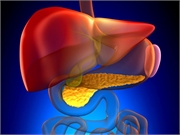Area under the ROC curve estimated by cross-validation was 0.62 for multifactor model
WEDNESDAY, April 22, 2020 (HealthDay News) — A model that includes data on clinical and genetic factors and circulating biomarkers may improve risk discrimination for pancreatic cancer, according to a study published online April 22 in Cancer Epidemiology, Biomarkers & Prevention.
Jihye Kim, from the Harvard T.H. Chan School of Public Health in Boston, and colleagues characterized absolute risk models that included clinical factors, germline genetic polymorphisms, and circulating biomarkers within a nested case-control study of 500 pancreatic cancer cases diagnosed after blood collection and 1,091 matched controls.
The researchers found that the area under the receiver operating characteristic curve estimated by cross-validation was 0.55 for the clinical model, 0.61 for the clinical/genetic model, and 0.62 for the clinical/genetic/biomarker model. The final integrated model identified 3.7 and 2.6 percent of men and women, respectively, who had a risk for pancreatic cancer that was at least three times greater than average in the ensuing 10 years. The risk for developing pancreatic cancer by age 80 years was 4 percent and the 10-year risk at age 70 years was 2 percent for individuals within the top risk percentile.
“Given the late stage at presentation for most patients with pancreatic cancer, earlier detection approaches are worthy of significant investment as a critical means to reduce mortality from pancreatic cancer, soon to be the second leading cause of cancer death in the United States,” the authors write.
Two authors disclosed financial ties to the biopharmaceutical industry.
Copyright © 2020 HealthDay. All rights reserved.








